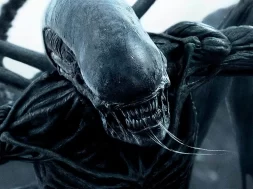Malgorzata Szumowska’s The Other Lamb comes at a unique time in American history. The coronavirus is currently a daily threat, and it’s being mishandled by our highest-ranking government leader. We’ve just seen to it that rapist and disgraced film producer Harvey Weinstein live his last years in prison. America is on the brink of major financial depression. We have just confirmed that many of our beliefs about what is “impossible” to improve our daily lives—such as free public transportation, elimination of standardized testing in schools, and even more opportunities to work from home—were based entirely on lies. Government officials are attempting to use the COVID-19 pandemic to limit abortion access, in yet another attempt to control the bodies and lives of women.
Such is similar in the life of Selah, played by Raffey Cassidy. Selah is on the verge of puberty and has lived her entire life as a “daughter” in an all-woman cult, save for their leader, Shepherd (Michiel Huisman). When Selah comes across another daughter who has begun menstruating (a sure sign of impurity according to Shepherd), Sarah aka “The Cursed Wife”, played by Denise Gough, warns that not all of Shepherd’s teachings hold true. Selah doesn’t believe Sarah, and accuses her of simply being “unclean”.
However, Selah comes to realize she may not be right about Sarah or Shepherd, after all. As the film goes on, Sarah continues to open Selah’s eyes. When the cult is forced to move from their land and find a new homestead, Selah must decide if she will continue on in a sect predicated on lies and misogyny.
Something that really stands out in The Other Lamb is its memorable imagery, thanks to cinematographer Michal Englert. Its colors are muted and grey-ish, which mirrors the dull lives of the women who live only to serve and worship Shepherd. Selah’s frequent, nightmarish visions of drowning are both beautiful and eerie, as her white dress seems to slow-dance in the murky water.
Particularly stunning is the gorgeous but foreboding landscape. The slanted trees in the dense woods surrounding the compound lend themselves to a feeling of complete isolation from the civilized world. Meanwhile, the mountainous countryside Shepherd has the group trek across reflects the difficult journey each woman in the group has endured while under his watchful eye. Englert has clearly taken great care to craft stunning frames while using the compound’s natural surroundings to emphasize the plight of Shepherd’s “flock”.
Szumowska’s understated direction also works in the film’s favor. The Other Lamb is quiet overall, which works to highlight the internal struggle of a young woman trying to determine her identity. The methodical pace of the film ratchets up the tension throughout and almost gives the impression that the film itself is holding its breath. When it finally gives way and lets the blood spill, the wait makes the end result all the more satisfying.
The Other Lamb, while it mostly seems to be a very dark drama, will likely draw comparisons to Robert Eggers’ The Witch, due in no small part to its similar ideology and symbolism. Like The Witch, The Other Lamb is sure to be deemed “art house” in nature. It’s slow-paced and subdued, which will likely turn off many looking for a scarier horror film. Some may also take issue with the messaging, as they did with The Witch. It’s important to note that, unlike the 2015 horror darling, The Other Lamb is fairly heavy-handed with its message, despite the delicate manner in which the rest of the film is handled.
The Other Lamb isn’t without its issues, namely flat characters and a somewhat predictable storyline. There are really only three developed characters, despite the large following Shepherd has amassed. Because none of the other characters besides Selah, Sarah, and Shepherd are very well fleshed out, they tend to appear crazed rather than preyed-upon or at all fearful. This does not, however, detract from the ability to feel empathy for these characters when Shepherd becomes violent or inappropriate with them.
While I couldn’t predict the exact end moments of the film, it wasn’t a real mystery what Selah would choose to do and believe. But the film doesn’t fancy itself a mystery. The intrigue is in seeing how Selah comes to know the truth about Shepherd and his predatory ways, and what she chooses to do with that new information. If you’re looking for something completely different, this isn’t it—but that’s not necessarily a bad thing.
The Other Lamb is a gripping meditation on the discovery of self and the gaining of independence. This horror-lite film will certainly linger when it’s over.
The timely questions posed by The Other Lamb will linger afterward, too. While the movie is undoubtedly meant to be for and about women rather than the American people, it still begs the question: What will our flock do with our knowledge? Will we continue to allow a self-appointed Shepherd to take control of/for us? Or will we realize our power and take a stand against his injustices, in order to create the nation we want to see?
IFC Midnight will release The Other Lamb on VOD platforms April 3rd.











